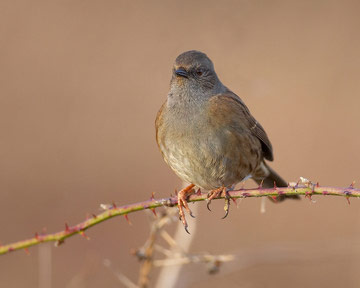
Dunnock © Richard Steel
There is little difference between the Dunnocks’ distribution or numbers in the breeding season and winter, and the birds recorded are likely to be the same individuals in both seasons. British Dunnocks are very sedentary, most individuals probably spending their whole lives within an area of radius 0.1 to 1 km. Some of the migratory population from Scandinavia appear on passage in eastern Britain, but there is no evidence of any reaching Cheshire and Wirral. The Atlas map shows the species to be missing from three of the highest eastern tetrads, just as it was found to be scarce above 300 m on the moors around Sheffield (Bevington 1991). The main difference in habitat recorded in winter is a drop in the proportion in woodland and scrub, with a substantial rise in birds in hedgerows.
At all seasons, Dunnocks find most of their food on the ground, by gleaning or turning over small leaves. In winter, the diet consists largely of small invertebrates (e.g. beetles, snails, spiders, flies, earthworms and spring-tails) but where food is provided for birds, they take a wide variety of small seeds, fragments of peanuts, bread crumbs and, less often, berries, small pieces of fat, meat and fruit. The BTO’s Garden BirdWatch shows that this is one of the species most likely to be found, Dunnocks ranking as the fourth most widely reported species in the gardens of northwest England.
Wintering Dunnocks tend to be solitary; observers recorded counts for more than 500 tetrads, but half of them were of single birds. I have been surprised to be able to ring up to twenty different birds in a morning at Meadow Bank Farm, Broxton (SJ45W) where they congregate to feed on wildbird seed crops, especially favouring the energy-rich quinoa.
Life can be hard for Dunnocks. In midwinter, individuals feed for over 90% of the daylight hours, dropping to 60-70% in March (Davies 1987) and in hard winters, the slightly smaller, and subordinate, females have to wander in search of food, and suffer higher mortality (BTO Winter Atlas).
Despite the rigours of winter, many Atlas fieldworkers noted Dunnocks in song from late January onwards, anticipating an early start to the breeding season.
Sponsored by Peter Walton

